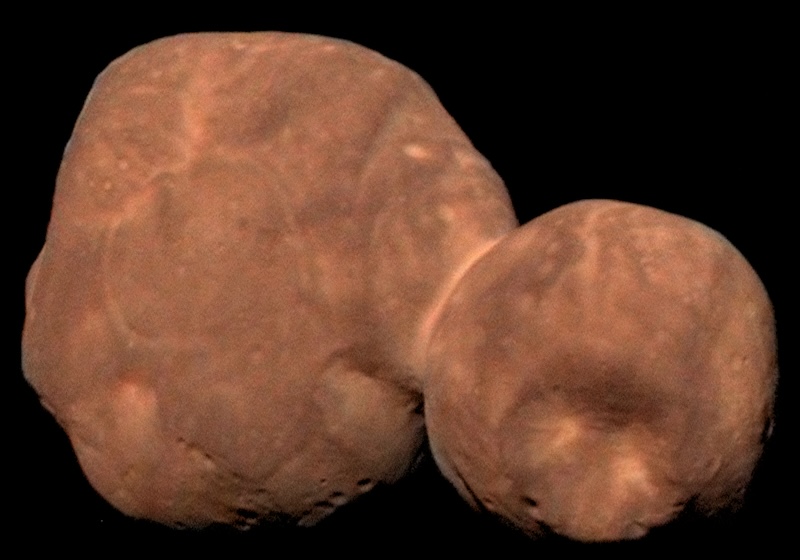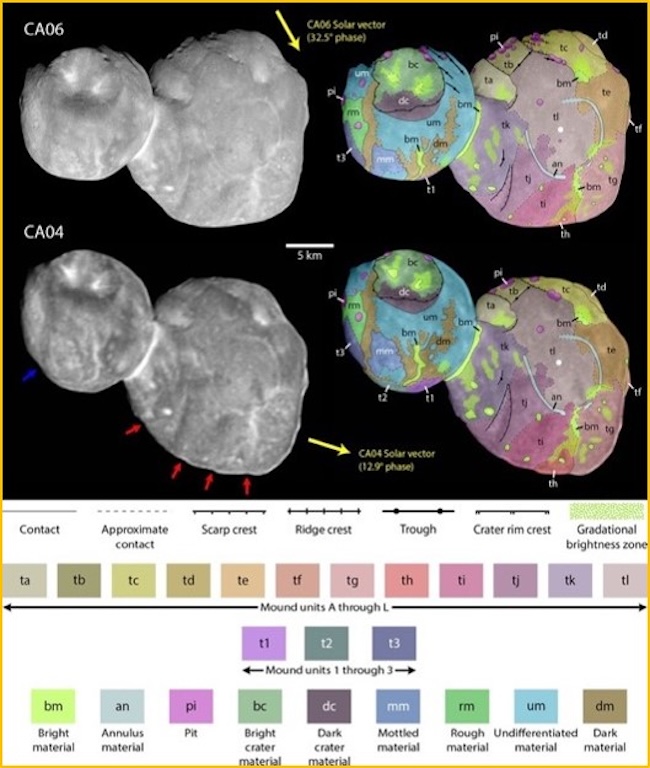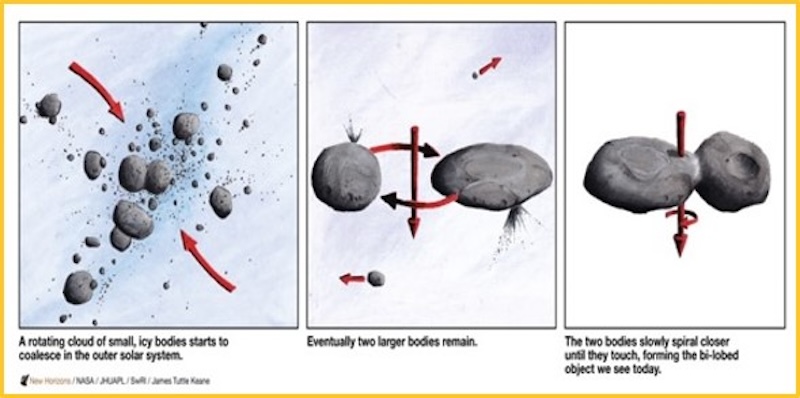
When – in the year 2019 – the New Horizons spacecraft hurtled past the Kuiper Belt object called Arrokoth (formerly known as Ultima Thule), it discovered a bizarre little world. Essentially, Arrokoth is 2 big roundish lobes, stuck together with a thin neck between them. Some people likened it to a snowman. There were some mysterious “mounds” on Arrokoth, in particular on the larger lobe. This month (October 3, 2023), researchers suggested the mounds share a common origin and are likely some of Arrokoth’s original ancient building blocks, unchanged for billions of years.
The mounds are big, relative to Arrokoth. End to end, Arrokoth measures about 22 miles (35 km) long. Meanwhile, the mystery mounds on the larger lobe are about 3 miles (5 km) long.
The research team was from the Southwest Research Institute (SwRI) in Boulder, Colorado. It was led by planetary scientist Alan Stern, who also leads the New Horizons spacecraft mission. These scientists published their peer-reviewed paper in The Planetary Science Journal on September 26, 2023.
The 2024 lunar calendars are here! Best Christmas gifts in the universe! Check ’em out here.
The mystery mounds on Arrokoth
Before New Horizons reached Arrokoth, deep in the Kuiper Belt way past Pluto, scientists only had a rough idea of what it might look like: somewhat dumbbell-shaped, or double-lobed. To be sure, the mounds were an interesting bonus. What were they? How did they form?
Altogether, New Horizons found 12 mounds on the larger lobe called Wenu and tentatively three on the smaller lobe, Weeyo. Moreover, they were all almost the same size, shape, color and reflectivity. The researchers said they are likely some of the original building blocks that Arrokoth is composed of, still clearly visible. The paper stated:
We report on a study of the mounds that dominate the appearance of Kuiper Belt Object (486958) Arrokoth’s larger lobe, named Wenu. We compare the geological context of these mounds and measure and intercompare their shapes, sizes/orientations, reflectance, and colors. The mounds are broadly self-similar in many respects and we interpret them as the original building blocks of Arrokoth.
Arrokoth’s large mound structures dominate the appearance of its larger lobe Wenu, with tentative crypto-mounds having also been identified on the limb of its smaller lobe, Weeyo.
Clues about Arrokoth’s origin
The observations provide valuable clues about Arrokoth’s formation. Stern explained:
Similarities including in sizes and other properties of Arrokoth’s mound structures suggest new insights into its formation.
Co-author Will Grundy added:
It’s amazing to see this object so well preserved that its shape directly reveals these details of its assembly from a set of building blocks all very similar to one another. Arrokoth almost looks like a raspberry, made of little sub-units.


Mounds on Arrokoth share a common origin
The data from New Horizons suggest that the mounds have a common origin. In this case, that common origin would date back to when Arrokoth first formed billions of years ago. As with planets and moons, the Kuiper Belt object formed when various chunks and bits of material collided together, creating the larger planetesimal now known as Arrokoth. According to the paper:
We believe that the self-similarity of the mounds argues for a common origin.
But why are the mounds all about the same size? Scientists don’t know yet. Stern said:
If the mounds are indeed representative of the building blocks of ancient planetesimals like Arrokoth, then planetesimal formation models will need to explain the preferred size for these building blocks.
In addition, the analysis results support the streaming instability model of planetesimal formation. In that scenario, the rocky material collides together at low speeds, only a few miles per hour. This allows the objects to gently accumulate. Thus, Arrokoth could gradually grow in size.
Do other planetesimals have building blocks?
The discovery of the mounds helps scientists better understand how planetesimals like Arrokoth originated. Current theory states that planets develop from planetesimals like these. So, do other planetesimals have similar mounds? As Stern noted:
It will be important to search for mound-like structures on the planetesimals these missions observe to see how common this phenomenon is, as a further guide to planetesimal formation theories.
With this in mind, NASA’s Lucy mission will be flying past some of the Trojan asteroids in the months and years ahead. Will any of them turn out to be pristine planetesimals like Arrokoth? Will they have similar mound features?
Arrokoth is 4.1 billion miles (6.6 billion km) away in the outer reaches of the solar system. It’s about 22 miles (36 km) long. It’s the most distant object in the solar system visited by a spacecraft so far.
Bottom line: Scientists at SwRI said that odd mounds on Arrokoth, a Kuiper Belt object, are likely some of the original ancient building blocks that it formed from.
Source: The Properties and Origin of Kuiper Belt Object Arrokoth’s Large Mounds
Read more: Today in 2015: New Horizons at Pluto
Read more: A new Earthlike planet in the distant Kuiper Belt?
The post Are the mystery mounds on Arrokoth ancient building blocks? first appeared on EarthSky.
0 Commentaires